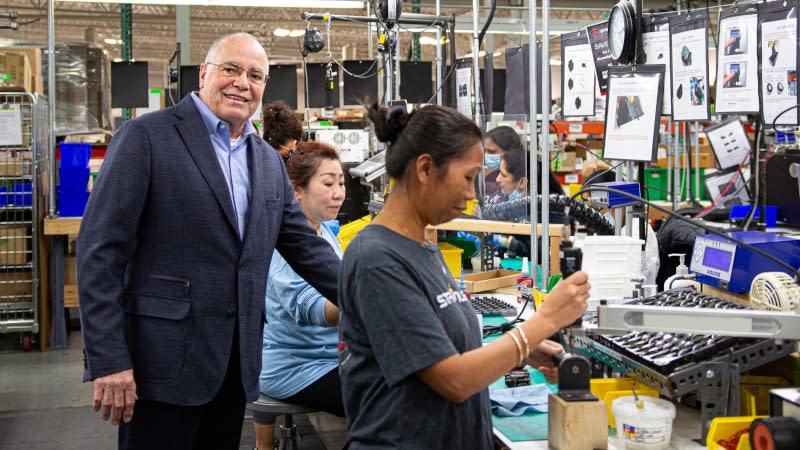Streamlight, Inc., a leader in providing durable, reliable lighting to police officers, firefighters, and other first responders, this year marks its 50th anniversary. The company’s success is grounded in its employees, its relationship with customers, and an ability to step forward and take chances with new products.
Streamlight CEO Shares Insight into Company’s 5o Years
Streamlight celebrates its 5oth anniversary this year and CEO Ray Sharrah has been with the company longer than anyone else. He takes time to explain how Streamlight has found success and longevity through its people and products.

Streamlight CEO Ray Sharrah visits the TLR production line earlier this week. He has worked with the company for most of its 50 years.
Streamlight
The company has created a culture where the employees feel like one big family, or so says Streamlight CEO Ray Sharrah. Many at Streamlight have longevity, but he is the leader of the pack when it comes to years of service. When he first took a part-time job with Streamlight in 1976 he never saw it as something that would become a career path, let alone one day lead him into the CEO role.
He started with the company while in college, and still recalls when it was just five or six people assembling lights by hand.
“We only had a single product in those days. It was the old Stream Lite 1-Million and they were unique individual custom-made products. Each one of them we had to tune at the electronics bench before we shipped them. So that's what I did,” he says. “For me, it was a part time job that helped to pay the college bills, amongst other part time jobs I had in those days. I was a little surprised to get a full-time job offer when I graduated, and I thought it would do for a while.”
That full-time job offer placed Sharrah into a sales manager role in 1978, but since those days he has worn many hats at Streamlight. So, when he points out what makes the company successful it is not simply coming from the CEO, but also from someone who has spent his entire adult career with the company.
“The secret to our success, number one, is we run the company like a family as much as anything. So, everyone's treated very, very well. We have very little turnover, we've got people with very long tenures,” explains Sharrah.
He says much of what the company does is in response to the needs of the market and another one of Streamlight’s strengths is the ability to have a finger on the pulse of what is needed in the field. They do so by having resources out in the field gathering good information about user needs. But Streamlight also tries different things from time to time.
“We're not afraid to try some things different in the field. We are mostly portable lighting guys, and gals, but we are brave enough to just try something different before the market asks for it,” says Sharrah. “Occasionally, some of them work and some of them don't. It's interesting how innovation carries its own special risks. Sometimes you can be handsomely rewarded, and sometimes you flop, but the willingness to take that risk is important.”
The longevity and wide adoption of the Streamlight brand is a testament to providing a quality product with needed features at a fair price. Overall, the grander value proposition of the brand is also in its service-minded approach to taking care of customers.
Quality Products and Service
Streamlight is not the cheapest game in town and Sharrah points out there are numerous global competitors that could claim that title now. But on the other end of the scale, Streamlight is not the most expensive product in the category.
“I'd like to say we offer an excellent value proposition, that we have an obsessive focus on reliability. We, the engineering department and the service department, are tied on a daily basis to feedback from the field and the customer experience,” he says.
Support is not only for customers who have more recently purchased Streamlight products. Sharrah says he has seen lights sold more than 30 years ago come into the repair facility to be serviced and Streamlight gets them back in operation for customers.
Although the company backs its products up with service and warranties, it is also dedicated to making the best product possible and confirming that the products work well long before they are released to consumers.
“We have what I'd like to think is probably the most extensive test facility in the business. We invest a lot in our testing and our ability to put products through the paces, both before they go into production and development,” he adds.
Sharrah explains, as an example, that Streamlight has an onsite shooting range so weapon lights can be thoroughly tested. Every product is tested with thousands of rounds of shots being fired, he says. Past that, a vibration-type machine is used to test the weapon lights past the amount of use they will see in the field. Advance testing of a new product usually lasts three or four months to make sure any new supplier’s parts are up to the Streamlight rigors, thereby maintaining the company’s reputation for quality.
That same testing mindset came into play for the new battery that fuels the Protac 2.0 series, a family of three versions of a 2,000-lumen rechargeable light. Although it is just slightly bigger than the standard 18650 battery, the larger cell in the Protac 2.0 series “packs a lot more punch,” according to Sharrah. A similar lithium cell has been around for several years, but Streamlight sought out a proprietary version and along with that came ample research and testing.
“Frankly, the battery itself took longer to qualify and find than the making the light really,” he adds.
The man, who has been around for every Streamlight produced since the early days, now grabs a Protac 2.0 as he heads out to walk his dog in the evenings.
“It's unparalleled ability to light up a piece of real estate in front of you is really comforting in a lot of ways,” Sharrah says.
Law Enforcement Market
“Personally, I cut my teeth in the law enforcement business. I mean, it was our first major market back in the 70s. We were a company looking for a customer in so many ways and we found that in the law enforcement profession, so it's always been a great source of pride,” says Sharrah.
Streamlight, Sharrah says, was the first to wrap an aluminum housing around a rechargeable halogen platform. That was the old SL-20, one of the first handheld Streamlights to see broad adoption by police officers back in 1975.
“That was our first really commercially successful product, we built the company on it. And I can remember, in those days, making rolling sales calls and all but the most open-minded cops felt that $50 for a flashlight was pretty crazy,” he recalls.
But agencies soon saw the value in a light that used a rechargeable battery. That rechargeable patrol light capability was what catapulted Streamlight into becoming a leader in providing law enforcement lights.
“It was a combination of good products, good timing, and good benefit to the customers,” he says.
The first light produced 1-million candle power and for many years, the company promoted candlepower then eventually adopted the more contemporary candela terminology. Then, the lighting industry shifted importance to lumen output, and Streamlight followed suit by making larger lumen output lights.
“The lumen thing grew. And we latched on to that and every portable light manufacturer did, I'm kind of seeing a renaissance of candela lately. There's more appreciation for reach in some applications,” Sharrah says.
Business Challenges
According to Sharrah, some of the biggest challenges the company has to face are not tied to the consumer, whether public safety or civilian.
“Some of the things that have consumed us, in terms of initiatives, have been the government regulatory environment. It's really surprising how many curveballs the EU and federal government here can throw at you in terms of regulatory compliance,” he explains.
Sharrah points to the State of California, which is known for creating a lot of environmental laws and adopting aggressive energy compliance standards ahead of other places in the country. As an example, he mentions Proposition 65 and the way California mandates manufacturers provide warnings about exposures to chemicals that the state deems could be harmful.
“We take a different approach to Prop 65 than a lot of companies. We want our downstream partners to be confident that we've checked that box and we're making sure our products are compliant without just putting the work-around wording on our website, which is what most companies do,” Sharrah says. “That sounds kind of trivial in some ways, but it can be very challenging on a company this size to make sure that you're fully compliant. I have to have a compliance department staffed with engineers.”
Another big challenge for Streamlight in recent years is protecting its brand by rooting out counterfeit products that can easily be sold by online vendors. The Streamlight team monitors all digital and resale platforms for such counterfeit products being sold as if they are true Streamlights.
But, there are unique ways Streamlight fights against the knock-offs market. The company trains agencies and officers that enforce customs at points of entry. Sharrah shares the example of the TLR line of weapons lights. None are made overseas, so any coming in through customs are bogus. The CEO says last year Streamlight hosted trainings at 15 to 18 ports of entry.
“So lately, that's one of our biggest challenges, just keeping the brand clean and making sure that when a customer buys it Streamlight that it's the real deal,” he says. “We have authorized resellers and that is that's your safest bet when you go to one of them.”
Moving Forward
This year marks Sharrah’s final full-time year with the company, then he will transition into an incremental executive role. But the longest-serving Streamlight employee will still be available to offer guidance.
“You can't just throw a switch and hang up the spurs and go about your business. It takes a number of years. So, this will be a five-year-plus process of passing the baton to the new team. This transition is imperative for business success, and the continued success of the business. We're very fortunate to have a great team coming up and in a lot of ways it's their turn to take the reins,” he explains.
Currently, Streamlight is working to return to its pre-pandemic pace of launching 20 to 25 new products each year. During the pandemic, Sharrah says, the launch of new products was cut about in half as Streamlight and many manufacturers faced supply chain problems.
“Our first goal was to keep our present customers happy and not introduce new products that we couldn't ship,” he adds.
The company remains headquartered in Eagleville, PA, where the majority of about 360 employees work. There are upwards of 30 employees who work remotely in sales or marketing and live in the territories they serve. The assembly facility is on site in Eagleville and currently Streamlight is renovating to expand the engineering room.
More Patrol

2 Florida Officers Shot After Shots-Fired Call
Two officers were shot in Gainesville, Florida, by a man who police say was leaving an area where he had killed a man inside a business. The suspect exited his vehicle in what the chief termed an “ambush-style” attack.
Read More →
Mistaken Identity: Ohio Police Department Harassed After ICE OIS
An Ohio police department has received harassing phone calls and social media messages because it has an officer with the same name as the ICE officer identified in the Minneapolis, Minnesota, officer-involved shooting.
Read More →
Top 10 POLICE Videos of 2025
What were the top videos published by POLICE in 2025? Many covered tactics and officer safety, while others came from booth visits at IACP in Denver, Colorado. In case you missed these, here are the top 10 videos.
Read More →
Flock Safety and Coreforce Partner to Enhance Real-Time Awareness and Operational Efficiency for Law Enforcement
A new integration partnership will enable Flock Safety hotlist alerts and license plate recognition (LPR) searches directly in Coreforce’s Real-Time Crime Center (RTCC) and Digital Evidence Management System (DEMS) platform.
Read More →
Ballistic Armor Co. Secures Strategic Investment to Expand U.S. Production Capabilities
Ballistic Armor Co. secured a new commitment that will accelerate its multi-year transition from a third-party tactical equipment retailer to a premium innovator and U.S. manufacturer of advanced protective systems.
Read More →
Police & Fire Championships Expands Athlete Eligibility
The US Police & Fire Championships is now open to all employees – sworn, civilian, administrative, technical, and support staff – who work directly for an eligible public safety agency.
Read More →
Tips for Watching the Hands
How can officers better “watch the hands”? Mike Willis, Law Enforcement National Training and Program Director for the US Deputy Sheriff's Association, shares some tips.
Read More →
10 Tips for Felony/High-Risk Stops
What steps can officers take to stay safer during felony or high-risk vehicle stops? Here are 10 tips from Mike Willis, Law Enforcement National Training and Program Director for the US Deputy Sheriff's Association.
Read More →
Amped Highlights Power Behind Amped FIVE Software
Amped FIVE empowers you to advance your investigations with confidence and precision, from the crime scene all the way to the courtroom.
Read More →
Police K-9 Killed, Suspect Dies in Shootout with Cops
A Burbank Police Department K-9 was fatally shot over the weekend by a passenger who fled on foot from a traffic stop. The armed suspect was killed in a shootout with officers.
Read More →

